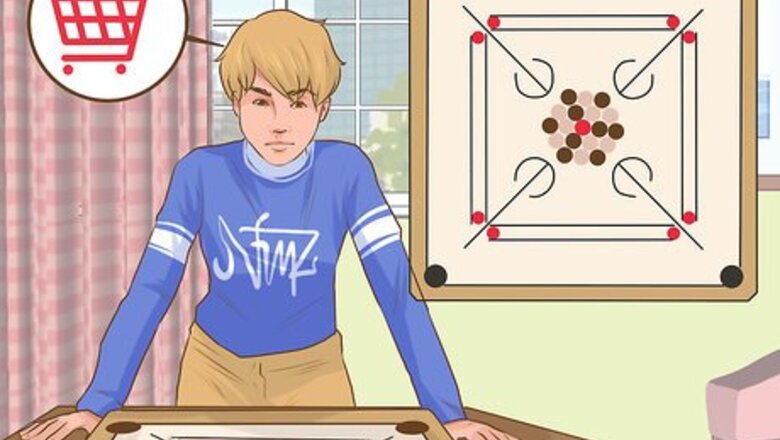
views
Preparing the Game
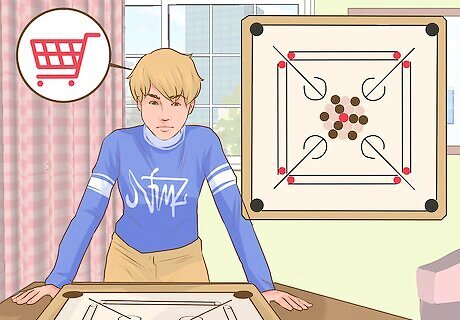
Purchase a Carrom board. The board should be a smooth wooden square of 72-74 centimeters. Each corner will have a 51 millimeter circular hole with a net under it, similar to a miniature pool table. The board has two concentric circles in the center, one the size of a playing piece and another larger circle. Two lines running at a diagonal from the corners create the foul lines. Lines running parallel to the sides create small rectangles known as the “Baseline.” Some players choose to lubricate the board with boric acid, potato starch, or chalk dust to allow the pieces to move more freely over the wood. This is representative of a traditional Carrom board. Other boards come in variations of sizes large enough to to push pieces as you would in shuffle board. Some boards can also be shaped in hexagons to allow for more players.
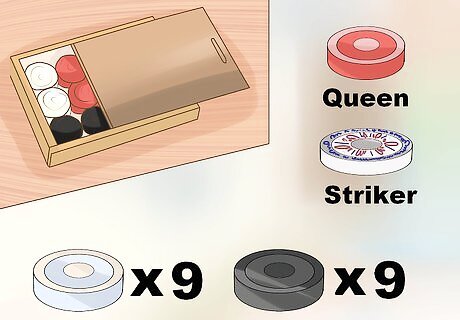
Collect the pieces needed to play Carrom. The game involves nine black or dark playing pieces, nine white or light-colored playing pieces, a red queen and a striker. Advanced players often own a personal striker. These can be up to four times heavier than a piece and are commonly made of bone or ivory. Each player can bring their own striker, or one striker can be shared among all the players.
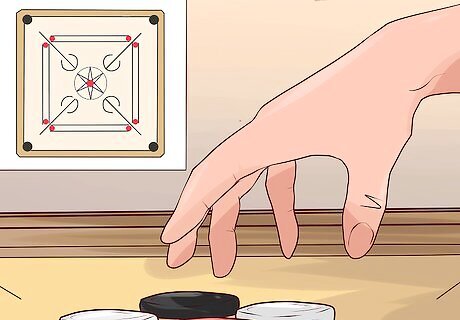
Place the queen in the center of the Carrom board. The queen is the red playing piece. Begin by placing the queen in the small circle in the center of the board. The remaining dark and light pieces will be arranged around the queen within the larger circle.

Arrange the light and dark playing pieces. Place the first light piece along the diagonal from the queen, in the direction of the pocket where you would like to strike the piece. Alternate dark, then light pieces in a circle, clockwise, using the queen as the center point. Place another light piece along the same diagonal as the original one, and alternate dark and light pieces clockwise around the first circle of pieces, until you have completed an outer circle of pieces.
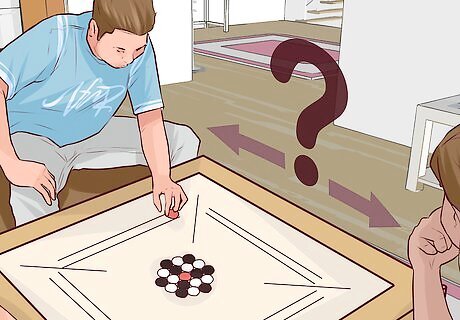
Determine who will strike first. One player will hold a game piece in one hand. The other player must guess which hand conceals the game piece. If the player guesses correctly, they can choose whether to strike first, or allow the other player the position of the light pieces, having them strike first and “break." If the player chooses the incorrect hand, the player who held the piece will get to choose whether to strike first or pass to the other player. The first player can also be determined by flipping a coin.
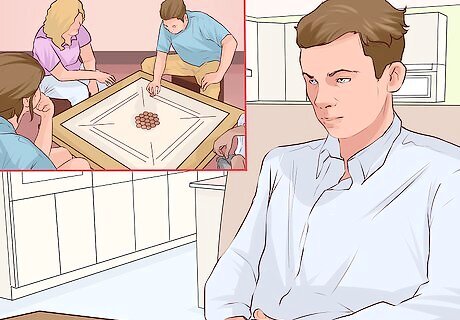
Choose your seat at the Carrom board. The player who strikes first will be seated in the position facing the lighter pieces. For a traditional, two-player game, the opponent will be seated on the opposite side of the board. Carrom is often played with four people playing as doubles. In this case, your partner is seated opposite you and assigned the same color pieces. Turns proceed clockwise in a game of doubles.
Striking the Pieces
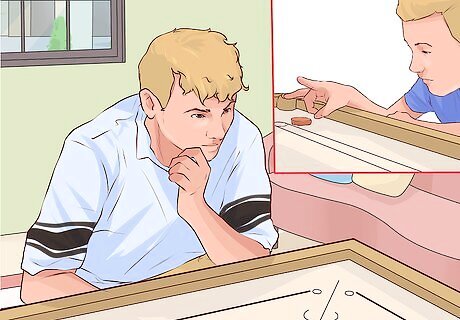
Seat yourself comfortably on your side of the board. All shots must be taken from a seated position. Be sure you are seated comfortably in a position where you can clearly see your shot and position your hand on the board for shooting. Players must remain seated. They can not get up from their chairs or move around the board. A player’s body must remain within their quadrant, which is created by the diagonal lines on the board. If those were to extend out past the board, this would be the player’s quadrant. Only a hand can cross the diagonal. Arms, legs, shoulders, and the rest of the body should not cross this imaginary line. Only your hand and arm can touch the board. Elbows must never touch the board.

Place the striker on the board touching both baselines. The baselines are the parallel lines running along your side of the board, which create the Carrom bed. The striker can be placed anywhere within the rectangle created by the baselines and the circles at the end. The striker must be touching both base lines. It can be placed directly in the center of the circle at the end of the lines. Otherwise, it should not touch the circle at all. The striker should also not be touching the diagonal lines in the corners. Replace the striker in the Carrom bed every time you shoot.
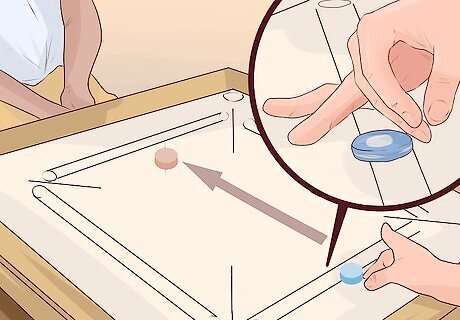
Flick the striker at the pieces you would like to hit. Players have different styles of flicking the striker. It is acceptable to use your index or middle finger. Choose whichever one is most comfortable for you. Rest the palm of your hand on the board. Touch your middle or index finger to your thumb, directly behind the striker. Apply some resistance on your finger, using your thumb, then flick your finger out and hit the striker to flick it across the board.
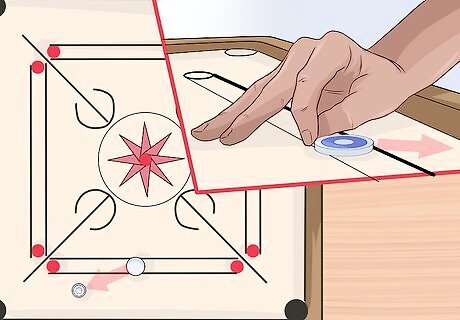
Shoot backward using your thumb or a scissor technique. If the piece you are aiming for is behind the striker from your seated position, you may need to shoot backward. In this case, you will want to adjust your technique for a back-shot. Shoot with your thumb by curling your index finger over the tip of your thumb. Apply pressure creating resistance on your thumb, then flick your thumb out of the finger lock to hit the striker. Create a scissor effect with your index and middle finger by slightly overlapping one over the other. Keeping both fingers straight, apply pressure with the top finger, then flick the bottom finger out in a scissor motion. This technique can also be used for a forward shot.
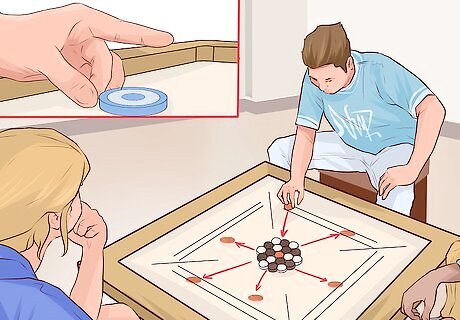
Break the pieces on the first turn. The white, or light colored player always strikes first. This player is responsible for breaking the pieces from the center by flicking the striker into the arranged pieces to break them apart. If the striker does not leave both lines, replace it and try again. The first player will get three chances to break. The player responsible for breaking alternates with each game. If you are playing doubles with four people, the turn moves counter-clockwise.
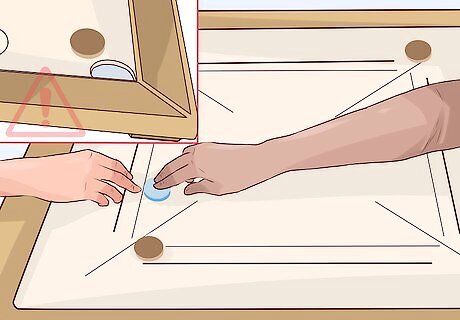
Pass the striker to the other player when you foul or fail to pocket a piece. The goal is to earn points and win the board by pocketing your pieces. Your turn will continue as long as you pocket your own color pieces by striking them into one of the corner pockets. When you fail to pocket a piece, or accidentally pocket the opponent's piece, your turn is over.
Scoring Points
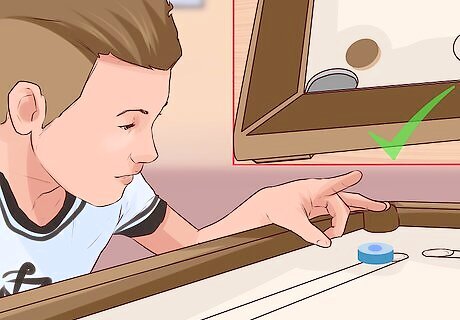
Pocket all your pieces to win the board. Once you have cleared all of your pieces by striking them into the pockets, you are declared the winner of the board. Collect one point for each of your opponent’s pieces which remain on the board once yours have been cleared. The goal is to collect 25 points or 8 boards to win.

Avoid sinking your opponent's pieces. Sinking the opponent’s pieces costs you your turn. Their piece stays in the pocket and puts them closer to winning the board. If you pocket your opponent's last piece, you also lose the board and three points.
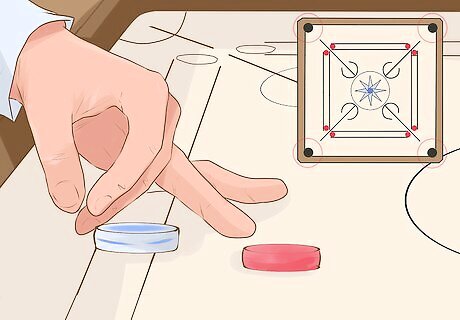
Cover the queen for three points. The queen is the red piece, which was placed in the center of the board. Once you pocket the queen, you must pocket one of your pieces in any of the corners on your next turn for the queen to be considered covered. If you fail to pocket a piece on the next turn, the queen is not covered and is returned to the center of the board. If one of your pieces is pocketed on the same shot when you sink the queen, this counts for covering the queen. The winner of the board collects three points if they also pocketed the queen. If the losing opponent pocketed the queen, no one gets the queen points for that board. Once the game reaches 22 points, no more points are issued for covering the queen.

Make a plan for covering the queen. The queen cannot be pocketed until you first pocket one of your pieces. You must pocket the queen before your last piece is pocketed, so that you can cover the queen with that piece. You lose the board, three points and a point for each of your opponent’s remaining pieces if you sink your last piece before covering the queen.
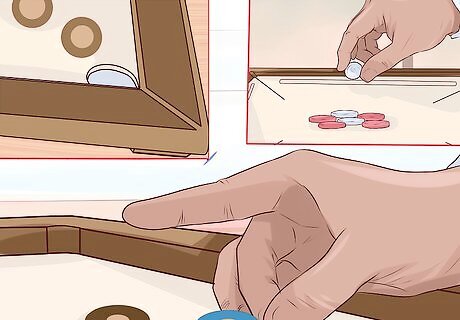
End your turn and lose one piece when you sink the striker. If you do not pocket one of your pieces, but you sink the striker, you lose your turn and one piece. Your opponent takes one of your pieces out of a pocket and places it back in the center of the board. If you have not yet pocketed a piece, it will be placed in the center when you do. If you sink both your piece and the striker, your piece is placed in the center of the board and you get to go again.




















Comments
0 comment